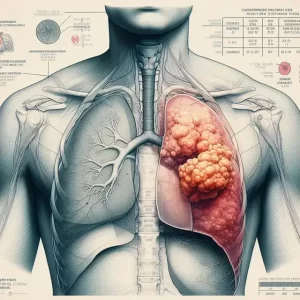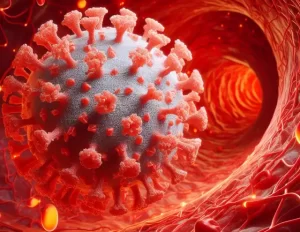Immunometabolism coevolution defines a unique microenvironment in renal clear cell carcinoma
- Brief Intermittent Exercise Reduces Heart Disease and Death Risk
- Personalized Lung Tumor Chips Assess PD-1 Therapy Response
- Study Shows Prior Infection Offers Strong Immunity to Original COVID-19 Strain
- Chinese Food Products Dominate Korean Tables Amid Safety Concerns
- Early Detection of Hypopharyngeal Cancer Possible with Saliva Diagnosis
- EB Virus Could Be Infected by Kiss: A Hidden Threat Linked to Cancer
Immunometabolism coevolution defines a unique microenvironment in renal clear cell carcinoma
- AstraZeneca Admits for the First Time that its COVID Vaccine Has Blood Clot Side Effects
- Was COVID virus leaked from the Chinese WIV lab?
- HIV Cure Research: New Study Links Viral DNA Levels to Spontaneous Control
- FDA has mandated a top-level black box warning for all marketed CAR-T therapies
- Can people with high blood pressure eat peanuts?
- What is the difference between dopamine and dobutamine?
- How long can the patient live after heart stent surgery?
Immunometabolism coevolution defines a unique microenvironment in renal clear cell carcinoma.
Metabolic changes in clear cell renal cell carcinoma ( ccRCC ) tumors are early events in tumorigenesis and evolution, which are closely related to widespread immune infiltration [1-4] .
Metabolic changes underlie malignancy and metastasis in ccRCC and may be a determinant of its response to metabolically targeted therapy [5,6] .
However, the relationship between the intratumoral metabolic heterogeneity of ccRCC and the massive infiltration of non-malignant immune cells remains unclear.
On June 27, 2023, the research group of Ed Reznik and A. Ari Hakimi from Memorial Sloan Kettering Cancer Institute published the article Immunometabolic coevolution defines unique microenvironmental niches in ccRCC in Cell Metabolism . Influenced to discover the co-evolutionary relationship between metabolism and immunity.
In addition, the authors used machine learning to discover metabolite biomarkers of treatment response, which has important guiding significance for the development of ccRCC treatment strategies.

First, to investigate metabolic heterogeneity within ccRCC, we collected 123 tumor samples and 64 adjacent normal tissue samples from 31 patients for integrated metabolome, genome, and transcriptome analysis, among which 31 tumor samples contained multiple tumor regions.
Metabolome analysis found that the metabolic heterogeneity among patients was higher than the intratumoral metabolic heterogeneity (Intratumoral metabolic heterogeneity, IMH ) of a single patient, and the metabolites that appeared differences could not be focused on a specific metabolic pathway, and IMH was not related to the development stage of the tumor, but IMH showed significant differences among different patients.
By integrating genomic data, we found that elevated IMH was not associated with ccRCC-specific genetic mutations; however, by integrating transcriptomic data, we found that elevated IMH defined a molecularly specific tumor subtype of ccRCC with distinct metabolic and transcriptomic signatures.
Specifically, the expression of immune pathway genes was negatively correlated with IMH, whereas pathways related to cell growth and proliferation were positively correlated. In addition, the authors found that gene expression and metabolites can fluctuate and adapt across different regions within a tumor.
Subsequently, to reveal the specific metabolites and metabolic pathways driving IMH in ccRCC, we calculated IMH for each metabolite within tumors, paying particular attention to metabolites of glycolysis, TCA cycle, and other central metabolic pathways, as these metabolic pathways were previously found to be involved in ccRCC development and metastasis.
Among these pathways of interest, certain metabolites exhibit unusually high heterogeneity relative to others in the pathway, cysteine being one of the most typical metabolites.
The authors found that regions with elevated cysteine levels had distinct metabolic flux patterns and were associated with upregulation of GPX4.
Meanwhile, principal component analysis and experimental data suggest that PC2-low tumor regions have increased susceptibility to ferroptosis, characterized by higher unsaturated fatty acid (PUFA) levels and OXPHOS activity, which can be compensated by upregulation of antioxidant biosynthesis to prevent ferroptosis . Thus, heterogeneity of these metabolites drives IMH in ccRCC.
Since immune cells and tumor cells were previously found to compete for nutrients and signaling factors in the ccRCC microenvironment [7, 8] , the authors speculated that the IMH of ccRCC may co-evolve with the immune microenvironment, resulting in specific metabolite abundance and immune cell composition patterns.
To systematically test this hypothesis, the authors used universal markers of RNA immune infiltration to study the interaction between the immune microenvironment and metabolic phenotype in each sample.
The analysis found that the metabolome could be altered by increased immune infiltration, including but not limited to NAD + metabolism, and that specific metabolites were strongly associated with the abundance of immune cells, thereby testing our hypothesis.
Further analysis of diverse myeloid and lymphocyte populations with pro- and anti-tumor properties revealed that myeloid cells drive changes in the abundance of N-acetylated amino acids, likely arising from tumor cell-intrinsic regulatory N-acetyltransferase expression induced by myeloid cell immune infiltration in the tumor microenvironment.
At the end of the article, the authors used the MIRTH machine learning algorithm previously developed by the research group [9] to infer unmeasured metabolites in the target dataset by learning the relationship between RNA and metabolite levels in a reference dataset where both RNA and metabolites are known to be identified.
Using MIRTH, the authors can efficiently infer metabolite levels in solid tumors and cell lines of different cancer types from RNA-sequencing data, and can identify otherwise hard-to-find metabolite biomarkers in publicly available databases.
In summary, this article comprehensively reveals the unique metabolic microenvironment of ccRCC by using multi-omics integrated analysis, that is, local metabolite plasticity is closely related to tumor cell phenotype and anti-tumor immune response, and immune infiltration drives intratumoral metabolite heterogeneity through the abundance of myeloid cells.
references
1. Hakimi AA, Reznik E, Lee CH, et al. An Integrated Metabolic Atlas of Clear Cell Renal Cell Carcinoma. Cancer Cell. 2016;29(1):104-116.
2.Gerlinger M, Rowan AJ, Horswell S, et al. Intratumor heterogeneity and branched evolution revealed by multiregion sequencing. N Engl J Med. 2012;366(10):883-892.
3. Şenbabaoğlu Y, Gejman RS, Winer AG, et al. Tumor immune microenvironment characterization in clear cell renal cell carcinoma identifies prognostic and immunotherapeutically relevant messenger RNA signatures. Genome Biol. 2016;17(1): 231.
4. Reznik E, Luna A, Aksoy BA, et al. A Landscape of Metabolic Variation across Tumor Types. Cell Syst . 2018;6(3):301-313.e3.
5. Cancer Genome Atlas Research Network. Comprehensive molecular characterization of clear cell renal cell carcinoma. Nature . 2013;499(7456):43-49.
6. Li B, Qiu B, Lee DS, et al. Fructose-1,6-bisphosphatase opposes renal carcinoma progression. Nature. 2014;513(7517):251-255.
7. Reinfeld BI, Madden MZ, Wolf MM, et al. Cell-programmed nutrient partitioning in the tumor microenvironment. Nature. 2021;593(7858):282-288.
8. Kilgour MK, MacPherson S, Zacharias LG, et al. 1-Methylnicotinamide is an immune regulatory metabolite in human ovarian cancer. Sci Adv. 2021;7(4):eabe1174.
9. Freeman BA, Jaro S, Park T, Keene S, Tansey W, Reznik E. MIRTH: Metabolite Imputation via Rank-Transformation and Harmonization. Genome Biol. 2022;23(1):184.
Immunometabolism coevolution defines a unique microenvironment in renal clear cell carcinoma
(source:internet, reference only)
Disclaimer of medicaltrend.org
Important Note: The information provided is for informational purposes only and should not be considered as medical advice.



